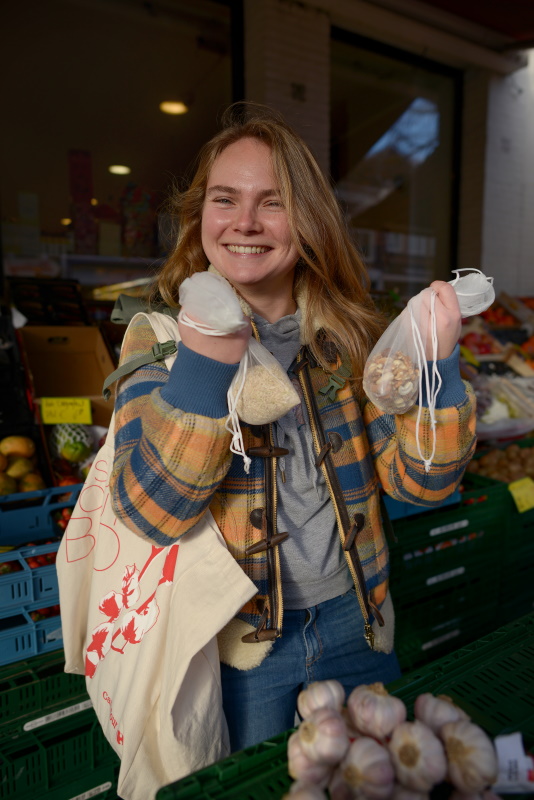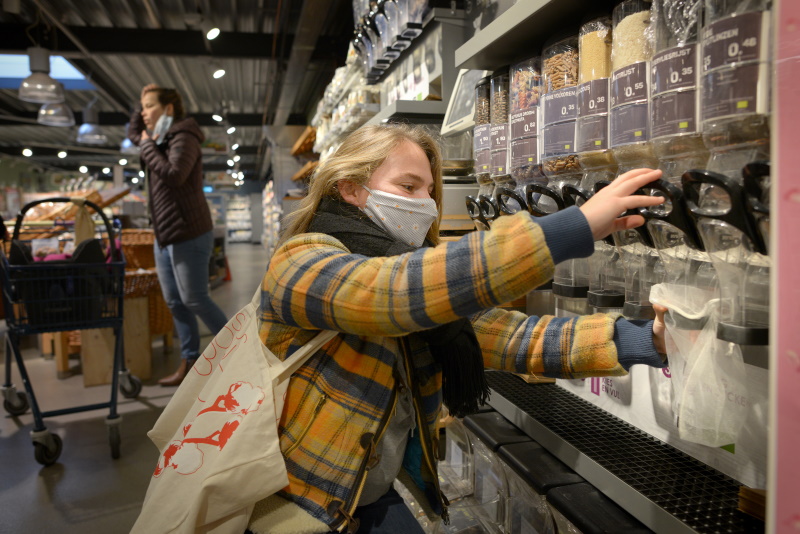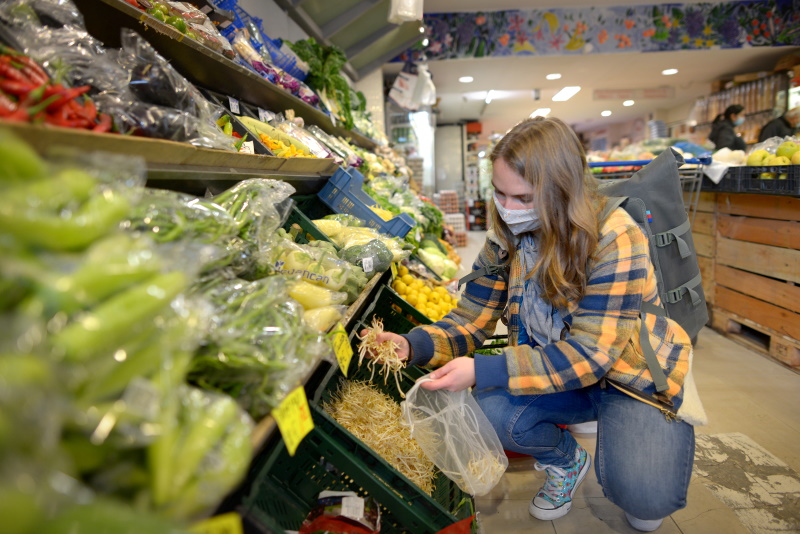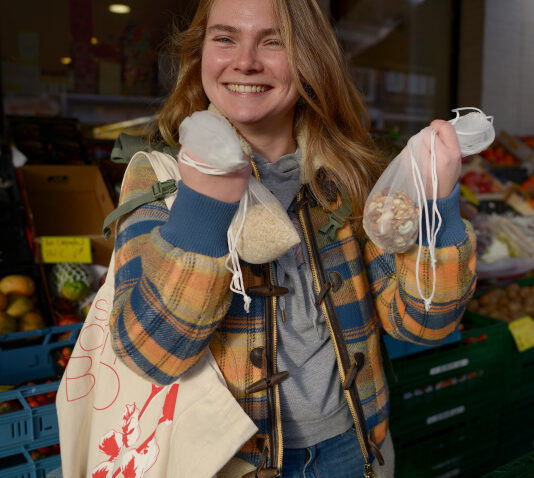If you buy your groceries without a jar, plastic, box or tin around it, that saves a lot of waste. That is why freshman Iris Broekmann shops without packaging: “I usually carry my own bags with me.”
Iris fishes a collection of cloth bags, nets and tea towels from her backpack. “There is nothing spontaneous about packaging-free shopping,” she laughs as she walks through the organic supermarket. “I always have to make sure that I have my own bags or a mesh net with me. Jars are also possible, but that is such a lugging. Sometimes I forget my bags, but I can also put things in a coffee mug or water bottle. Anything to avoid producing waste.”

Tapping rice.
Today, Iris is in the Ekoplaza in Zwolle, one of her regular addresses. Here you can tap your own rice, pasta, chickpeas and nuts. “Look, you just hang your bag under it and take as much as you want. Just weigh it up and then you can pay.” Iris points to the chickpea self-tap. “It gets more difficult there. I really like chickpeas, but these are raw. You have to soak them in water for twelve hours before you can cook with them. I am willing to do a lot, but it takes too much time for me. So sometimes I opt for convenience and go for chickpeas in a can or jar. Fortunately, cans and glass are easier to recycle than plastic. Plastic is really bad for the climate, so I try to avoid that.” More and more people in the Netherlands shop this way. There is even an online supermarket that delivers packaging-free groceries to your door. Without a shell, that is also what Iris strives for, although she mainly focuses on buying as little stuff as possible with a plastic bag, cellophane or container.
To various stores.
Iris: “Every piece of plastic is a piece of waste. People think that you can recycle plastic well, but that is not always the case. Moreover, processing waste is bad for the climate. If we all went shopping without packaging, the packaging would no longer be produced. A bit idealistic, because that probably isn’t going to happen. But I contribute what I can.”
According to Iris, it is mainly about knowledge. “People need to know that things can be done differently. And where you should be. And of course, it is also about convenience – which you simply have more with ‘normal’ shopping. The Albert Heijn can be found everywhere and is open until late. You go there faster than to the organic supermarket, which is located in fewer places and is open less often. Moreover, you will find everything in one building at the regular supermarket. While you have to go to different stores for packaging-free shopping.”
Single-use plastic.
There is a price tag to shopping like Iris does. “The Ekoplaza is of course more expensive than the supermarket. And if you want to buy a block of cheese without packaging, you have to go to the cheesemonger. It is also more expensive than the supermarket. But the greengrocer is again cheaper, or just as expensive, and with much less packaging.”

So off to the greengrocer. Iris lets her eyes slide over the many boxes with fruits, vegetables and herbs. She points to the spinach, which is lying here without a bag in a box. “In the supermarket, there is often single-use plastic around vegetables. You can never use that again. Very crazy, actually. Because in many cases that packaging is not even necessary.”
Ginger, fresh herbs, courgettes, grapes: Iris fills her own bags with food for the next few days without feeling guilty. She even buys bean sprouts without packaging. She fishes a hand full from a large box and puts it in her own net. What does she pay? “Thirteen euros. I couldn’t have done that at the supermarket.”
Deposit system.

But what about other types of groceries, such as meat? Can you buy everything without packaging? “I don’t eat meat, I eat vegetarian and vegan as much as possible. But I do eat meat substitutes like tofu, and they come in a package. Some products are simply not for sale without packaging. Completely packaging-free shopping is therefore impossible. But you can opt for smarter solutions. For example, I order my basic groceries at Pieter Pot, an online supermarket. All their stuff comes in glass jars. Not packaging-free, but with packaging that can be reused. It works like a deposit system: when your next order comes, you return the old jars. In this way, as a consumer, you do not produce any waste. They don’t have tofu at Pieter Pot by the way. If I want that, I have to buy it in a plastic container at the store.”
What Iris does not order from Pieter Pot, she buys from other stores – such as the greengrocer and Ekoplaza. “And I order things online. Shampoo for example. That is then a shampoo bar; the same idea as a bar of soap. It comes in cardboard packaging. Toothpaste is available in tablets, in a deposit jar.”
There are limits.
The last stop for today is the Turkish bakery. It is late afternoon and most of the loaves have already been sold. There are still a few. In plastic. When Iris asks the baker if he still has unwrapped bread, he shakes his head. “Without packaging, the bread dries out.” And now? Iris shrugs. “If there really is no other option, I buy it with packaging. I just need bread. And in terms of time, I can’t keep cycling through the entire city and looking for that one loaf of bread without plastic around it. I do as much as I can, but there are limits.
Text: Silke Polhuijs
Photo’s: Jasper van Overbeek
